1997.07.19
Towards a New Dexterity
The new capabilities brought by CAD--scale/rotation manipulation, patterning, 3D, hidden-line, multi scales, multi “originals.”
C. Tomkins’ New Yorker article on manual skill.
different x, y (& z) scales for all digital material
the non-linear use of scanners
playing with CAD models
cut and paste
crazy use of architecture specific CAD drawing commands
crazy quick (3-D) sketch plans
html as self publishing
...via the new technology that created the new dexterity. Exploit the new possibilities to their extreme, especially using the various mediums in unorthodox ways.
1997.07.20
(original) Book of Drawings
...start creating interesting drawings using CAD and manipulating all the data I already have available and then combining the line drawings with scanned imagery and text.
This project might be the laboratory for Towards a New Dexterity...
1997.07.25
new dexterity - further thinking
...more investigating with Arris patterning.
...pattern square symmetrical plan formations, and then see what other architectural plans develop. ...might find it interesting to use plan examples from the Campo Marzio.
...doing different x&y scale changes to the Campo Marzio plans.
...the kit of parts and the collaging of ideal.db will be perfect examples of their respective new capabilities. The “analogous building” is also a new form of dexterity.
1997.08.09
experiments with the philly model/virtual history
apply patterns and all kinds of architectural imagery to the wireframes of the buildings. I could really create a surreal environment...
Parkway Interrotta
Unbuilt Philadelphia
collage city
What these projects have in common is, of course, virtuality, and perhaps that is the theme that I will always follow when working with the city model. (Piranesi’s Campo Marzio is not a real Rome, it is a virtual Rome.) Virtuality can here be used to demonstrate a new fork in the road of historiography... ...begin to take its place beside “traditional” history.
rotation/scale manipulation of the philadelphia model parts.
...potential commentary regarding urban design in the computer age (or perhaps just in the virtual realm). I am reminded of my positive impression of downtown Pittsburgh with its collage of street grid patterns, and thus its strong contrast to the ubiquious orthagonal grid of C.C. Philadelphia.
| |
1998.04.06
Towards a New Dexterity Introduction
"It would quickly be seen that the tools that man has made for himself, . . . and which till now have undergone only slight modifications in a slow evolution, have been transformed all at once with an amazing rapidity. These tools in the past were always in man's hands; today they have been entirely and formidably refashioned and for the time being are out of our grasp. The human animal stands breathless and panting before the tool that he cannot take hold of; progress appears to him as hateful as it is praiseworthy . . . This is a great but critical period, . . . we must create the state of mind which can understand what is going on . . . we will see that things have changed: and changed for the better."
Le Corbusier, Towards a New Architecture (New York: Praeger Publishers, 1960), p.251.
The above quotation, written in 1923 and taken from the opening paragraph of "Architecture or Revolution" (the concluding chapter of Le Corbusier's Towards a New Architecture), unwittingly prophesies the arrival of Computer Aided Design (CAD) in the world of architecture, and, more specifically, its arrival in the world of architectural drawing. A computer installed with CAD software is indeed a new drawing tool, one that has not "refashioned" the old tools as much as it has replaced them. Pencils, triangles and parallel rules are simply no longer necessary to produce a drawing. CAD has essentially eliminated the need for manual skill, that is, the traditional graphic dexterity of the architect/delineator. Until now, an architect's drawing could be appreciated for both the manifestation of an idea and for the dexterity behind the idea's presentation. It has always been the combination of mind and hand that generates an architectural drawing's appeal.
| |
It is a mistake to view CAD as only a negative influence within architectural delineation and design, however. Indeed, CAD's contribution towards the enhancement of manual dexterity clearly surpasses its annulling attributes. A prime case in point is any individual who is capable of conceiving design ideas in their mind, yet, because of a physical handicap such as the loss of use of a hand, the same individual would be hard pressed to present the design idea using traditional means of delineation. It is here that CAD literally enables handicapped individuals with a real ability to draw. As this example demonstrates, CAD, more than anything, impels the artistic community at large to seriously reconsider the whole notion of handicraft.
The purpose of "Towards a New Dexterity" is to illustrate precisely the enhancements CAD brings to the realm of architectural delineation. Moreover, because of "drawing's" close association with design, this inquiry will also touch upon CAD's potential influence on an architect's design methodology.
Patterning
This investigation of new dexterity begins with a look at CAD and its capabilities with regard to patterning. Initiating this study with patterning is both intentional and appropriate since patterns are synonymous with the very origins of drawing and design itself. CAD, in this particular case ARRIS CAD, makes it not only easy to fill large areas of a drawing with patterns, but it also inadvertently discloses a hertofore unrecognized "constitution" within specific patterns themselves. This revelation of hidden properties within certain patterns may or may not amount to an actual discovery, but if it is a discovery, then it was found through CAD.
|
Patterning
Like most high-end CAD software, ARRIS CAD offers a full range of patterning and cross-hatch capabilities. A CAD user easily sets the composition of the pattern by either line or repeated item (block), and the resulting pattern can fill any shape up to 255 sides. In the case of line patterning, ARRIS offers the capability of creating cross-hatching containing up to four separate line, with each set at its own angle and spacing, and thus the cross-hatch possibilities are virtually endless.
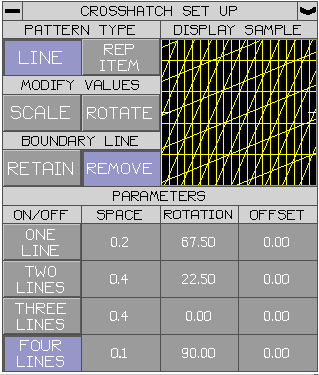
Patterning with a repeated item (block) operates somewhat differently than cross-hatch, however. The design of the repeated item used to fill a designated area is entirely at the user's discretion. Of courese, any combinations of lines and shapes are useable, but the occurrance of a regular resultant overall pattern depends on the regularity of the base repeated item.

examples of repeated items used for patterning and the resultant pattern fill
As with line patterning, ARRIS CAD offers the capability of setting repeated item patterning to a specified angle. The resultant pattern fill is not what would be normally expected, however, because each repeated item within a filled area rotates individually rather than contiguously.

examples of repeated items used for patterning and the resultant pattern fill when the pattern angle is set to 15 degrees
To achieve a contiguous rotated repeated item pattern fill, the pattern must be set to 0 degrees and what in ARRIS CAD is called the work angle may be set to any angle. Even though a few extra steps are required, ARRIS CAD users are still able to generate the rotated pattern normally expected.

examples of repeated items used for patterning and the resultant pattern fill when the pattern angle is set to 0 degrees and the work angle is set to 15 degrees
It would first appear that having repeated items rotate individually by default inside a specified pattern area is a problem within the ARRIS program code that should be fixed, however, this is not the case here. In fact, this odd bit of CAD programming discloses a heretofore unseen "nature" within a very specific type of pattern. Of the four pattern examples illustrated thus far, the first three base repeated items fit within a square, while the fourth repeated item fits within a rectangle, and rotating the pattern of these same repeated items by 45 degrees leads to a discovery. Since the first three repeated items fit within a square, rotating them 45 degrees creates an entirely new and distinct contiguous pattern!

examples of repeated items used for patterning and the resultant pattern fill when the pattern angle is set to 45 degrees
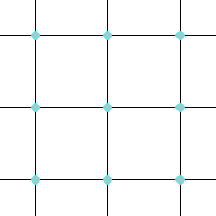
pattern rotation at 15 degree intervals -- The best way to illustrate the rotation/creation process is through animation.
At this point, it is not hard to imagine the unlimited creation of new and stimulating patterns, and to this end, the following repeated items offer only a small sample of the immense patterning possibilities.
| |
Pattern 1
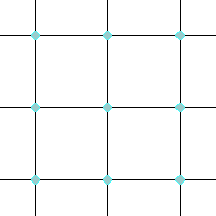
pattern 1 rotation at 15 degree intervals
| |
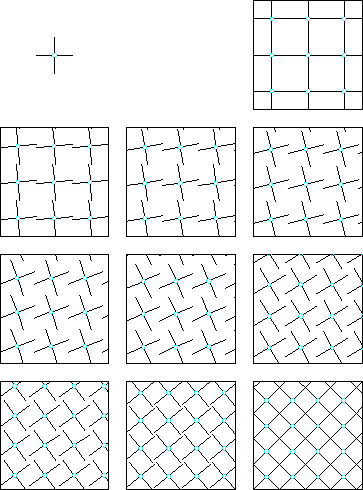
pattern 1 rotated at 5 degree intervals
|
Pattern 3
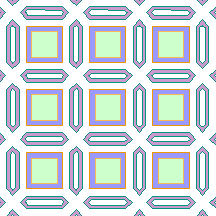
pattern 3 rotation at 15 degree intervals
| |
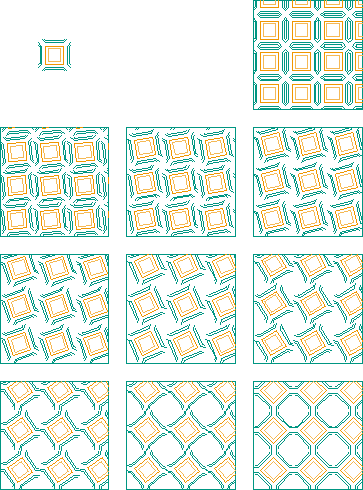
pattern 3 rotated at 5 degree intervals
|
Pattern 6
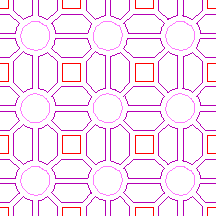
pattern 6 rotation at 15 degree intervals
| |

pattern 6 rotated at 5 degree intervals
|
|
Pattern 11
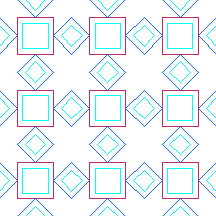
pattern 6 rotation at 15 degree intervals
| |
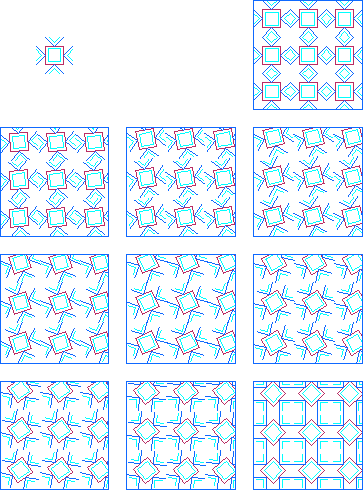
pattern 6 rotated at 5 degree intervals
|
Pattern 15
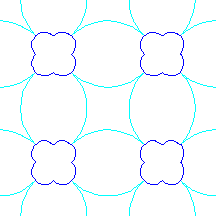
pattern 6 rotation at 15 degree intervals
| |

pattern 6 rotated at 5 degree intervals
|
Pattern 16

pattern 6 rotation at 15 degree intervals
| |
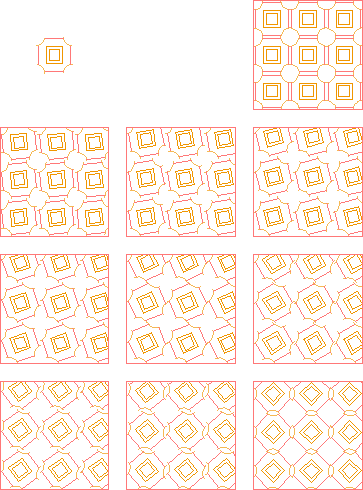
pattern 6 rotated at 5 degree intervals
|
| |
Pattern 17
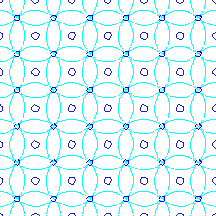
pattern 6 rotation at 15 degree intervals
| |
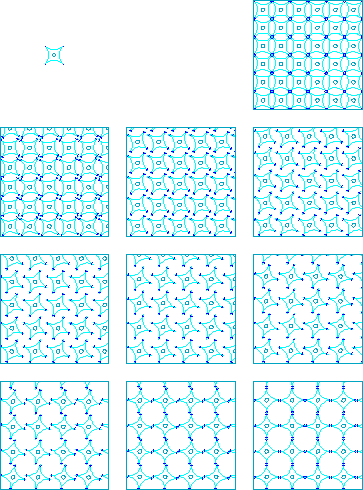
pattern 6 rotated at 5 degree intervals
|
Pattern 20
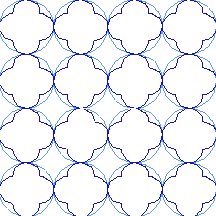
pattern 6 rotation at 15 degree intervals
| |
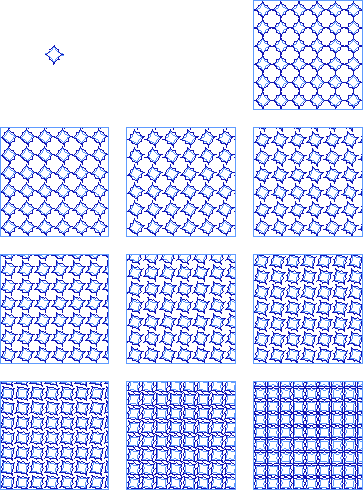
pattern 6 rotated at 5 degree intervals
|
Pattern 23
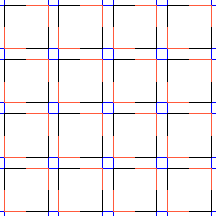
pattern 6 rotation at 15 degree intervals
| |
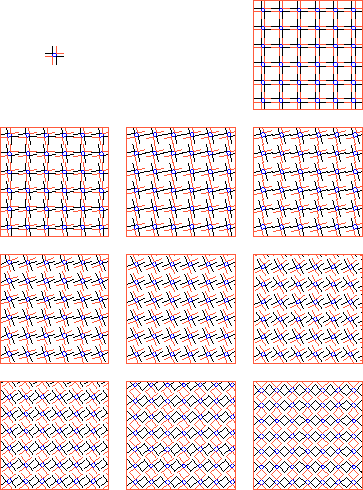
pattern 6 rotated at 5 degree intervals
|
|
|























